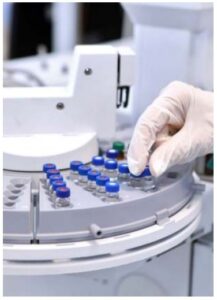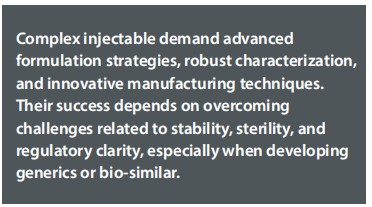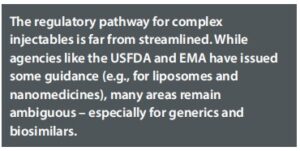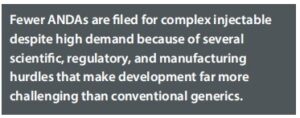COMPLEX INJECTABLES
Opportunities, Challenges, and the Road Ahead

By Dr. Govind S Pandey
In the evolving world of pharmaceutical and drug delivery sciences, complex injectables have emerged as critical enablers of modern therapy. These advanced parenteral systems go far beyond simple aqueous or oil-based solutions, offering targeted, sustained, and controlled drug release, improved bioavailability, and increased therapeutic precision. As the pharmaceutical industry shifts toward treating chronic diseases, cancers, and autoimmune disorders with biologics, peptides, and nanoparticle-based agents, complex injectables are becoming essential.
Complex injectables hold tremendous promise – but they are also among the most technically challenging dosage forms to develop, characterize, manufacture, and scale. This article explores the key scientific principles behind complex injectables, the hurdles they face across the product lifecycle, and the growing global market shaping their adoption.
Understanding Complex Injectables

Complex injectables are defined not merely by their route of administration (parenteral) but by the intricate composition and engineering of their delivery systems. Unlike conventional solutions or suspensions, they often involve
- Liposomes and lipid-based carriers
- Microspheres and nanoparticles
- Emulsions (oil-in-water, water-in-oil)
- Depot injections and polymeric implants
- PEGylated proteins or long-acting formulations
These systems are designed to address specific pharmacokinetic and pharmacodynamic challenges – such as poor solubility, short half-life, or the need for targeted delivery to specific tissues. For example:
Liposomal Doxorubicin (Doxil®) allows for slower systemic clearance and targeted tumor delivery, reducing cardiotoxicity.
PEGylated Interferon-α improves half-life, reducing injection frequency in hepatitis therapy.
Depot formulations of Risperidone or Leuprolide offer once-monthly or quarterly dosing, improving compliance.
Scientific & Technical Challenges
Developing complex injectables requires expertise across formulation science, analytical chemistry, manufacturing technology, and regulatory affairs. Let’s explore the key hurdles in each stage of development:
- Formulation Development
Complex injectable formulations require precise control over particle size, morphology, and surface properties, as these factors affect the release rate and bioavailability. They also necessitate drug-excipient compatibility studies to prevent leakage, aggregation, or degradation during storage. Additionally, the selection of biocompatible polymers or lipids must be tailored to the drug properties and the intended route of administration, whether intravenous (IV), intramuscular (IM), or subcutaneous (SC).
Stability is a recurring concern – particularly for emulsions and suspensions that may undergo phase separation or oxidation if not properly stabilized.
- Characterization Complexities

Unlike tablets or capsules, where dissolution and assay methods are standardized, complex injectables demand advanced analytics. Techniques such as Dynamic Light Scattering (DLS) are used for particle size analysis, while Electron Microscopy (including TEM and SEM) provides detailed morphological analysis. Zeta potential and encapsulation efficiency are assessed to evaluate formulation quality, and in-vitro–in-vivo correlation (IVIVC) models are employed to predict performance.
Batch-to-batch reproducibility is harder to establish due to inherent variability in biological materials and nanoscale processes.
- Manufacturing & Scale-up
Manufacturing involves techniques such as microfluidics, high-pressure homogenization, and co-milling. It also requires maintaining aseptic conditions through the use of isolators, Restricted Access Barrier Systems (RABS), and adherence to cleanroom classifications. Additionally, lyophilization or freeze drying is employed for temperature-sensitive actives.
Scale-up from bench to commercial scale is often non-linear. A process optimized at 1L may behave unpredictably at 100L or 1000L without meticulous design of experiments (DoE) and process analytical technology (PAT) tools.
- Sterility & Stability
Sterility is mandatory for parenterals, yet terminal sterilization (e.g., autoclaving) can degrade many advanced formulations. Hence, aseptic processing is commonly required, increasing capital and operational costs.
Long-term stability remains difficult, especially for lipid-based emulsions due to the risk of oxidation, liposomes and microspheres because of the risk of leakage, and proteins and peptides owing to the risk of aggregation or denaturation.
- Delivery Systems & Patient Factors
 Drug-device combinations are a growing trend. Auto-injectors, wearable pumps, and prefilled syringes increase patient convenience but introduce additional design, testing, and regulatory requirements.
Drug-device combinations are a growing trend. Auto-injectors, wearable pumps, and prefilled syringes increase patient convenience but introduce additional design, testing, and regulatory requirements.
Delivery must consider injection site and volume limitations, variability in muscle or fat mass, and the patient’s ability for self-administration.
Cost-Related Challenges
High capital investment: Specialized equipment like lyophilizer, microfluidic systems, and aseptic filling lines are expensive to install and maintain.
Process validation costs: Scaling up requires extensive validation to ensure consistency, sterility, and quality – each step adds regulatory and financial weight.
Batch-to-batch variability: Complex formulations (e.g., liposomes, microspheres) often behave differently at scale, leading to costly reformulations or failed batches.
Skilled workforce: Hiring and training experts in sterile manufacturing, nanotechnology, and regulatory compliance adds to operational costs.
Infrastructure Challenges
Sterility assurance: Maintaining aseptic conditions across thousands of vials is far more difficult than in lab-scale setups.
Environmental sensitivity: Temperature, humidity, and airflow variations can affect lyophilization, emulsification, and stability requiring tightly controlled cleanroom environments.
Regulatory ambiguity: Lack of clear guidelines for novel injectable (e.g., nanoparticle suspensions) makes scale-up risky and time-consuming.
Regulatory Landscape: Complexity Meets Ambiguity
The regulatory pathway for complex injectables is far from streamlined. While agencies like the USFDA and EMA have issued some guidance (e.g., for liposomes and nanomedicines), many areas remain ambiguous – especially for generics and biosimilars.
Challenges include the lack of clear criteria for bioequivalence due to variable release profiles, as well as the difficulty in demonstrating pharmaceutical equivalence for physical mixtures or nanocarriers. There is also regulatory uncertainty for drug-device combinations, such as the need for dual reviews by CDRH and CDER in the US.
Furthermore, limited global harmonization poses issues, as what is acceptable to the FDA may not be aligned with regulatory bodies like the EMA, CDSCO (India), or ANVISA (Brazil).
For generics, many must file via hybrid or 505(b)(2) pathways, involving substantial bridging studies and even clinical data.
REGULATORY HURDLES
Complex injectable face several unique regulatory hurdles that set them apart from conventional generics:
Lack of Clear Approval Pathways: Often needs hybrid applications.
Demonstrating Equivalence: Proving pharmaceutical and bioequivalence is harder due to complex formulations (e.g., liposomes, microspheres, nanoparticles).
Characterization Complexity: Advanced delivery systems need specialized analytical tools to assess particle size, release kinetics, and stability.
Drug-Device Combinations: Dual regulatory evaluation (e.g. prefilled syringes).
Global Harmonization Gaps: Definitions and approval criteria vary across regions (e.g., FDA vs EMA), making international registration more complex.
Market Growth & Opportunities
Despite the barriers, the complex injectable market is growing rapidly, driven by:
a) Therapeutic Demand
Oncology: Liposomes, ADCs, and monoclonal antibodies dominate injectable cancer care.
Autoimmune Diseases: Self-injectable biologics for rheumatoid arthritis, psoriasis, etc.
Diabetes: Long-acting insulins, GLP-1 analogs, and wearable injectors.
Infectious Diseases: Liposomal antimicrobials for resistant infections.
b) Technological Advances
Technological advances include innovations in PEGylation, lipid nanoparticle carriers, and solid lipid nanoparticles (SLNs). Additionally, AI and machine learning are increasingly used in formulation modeling and predictive stability. There is also growing integration of digital health tools to support adherence and monitor treatment outcomes.
 c) Policy & Regulatory Momentum
c) Policy & Regulatory Momentum
Policy and regulatory momentum is building through initiatives such as the USFDA’s Complex Generics Guidance and India’s Production Linked Incentive (PLI) scheme for injectables, support research and development, and manufacturing. Additionally, international CDMOs are increasingly specializing in sterile manufacturing and offering comprehensive formulation-to-filing services.
THE KEY DRIVERS
The global complex injectable market is rapidly expanding due to several technological, clinical, and economic factors. The key drivers include:
Rising Demand for Targeted and Long-Acting Therapies
Complex injectable offer controlled, sustained, and targeted drug delivery, which improves therapeutic outcomes and patient compliance – especially in chronic diseases like cancer, diabetes, and auto-immune disorders.
Growth of Biologics and Biosimilar
A surge in the use of monoclonal antibodies, vaccines, and peptide/protein therapies which require complex delivery systems has significantly contributed to market growth.
Increasing Prevalence of Chronic and Lifestyle Diseases
Conditions such as cancer, rheumatoid arthritis, hormonal disorders, and CNS diseases demand advanced delivery systems for drugs that are unstable or poorly soluble, often administered through complex injectable.
Technological Advancements in Drug Delivery
Innovations in liposomes, nanoparticles, microspheres, depot formulations, and PEGylation technologies have enabled more efficient and safer injectable drug products.
Favourable Regulatory Support
Regulatory bodies like the USFDA, EMEA, and Indian CDSCO are providing guidance documents and incentives to support the development and approval of complex generics, especially for injectable.
Growing Investment in R&D and CDMOs
Pharmaceutical companies are increasingly investing in R&D partnerships, outsourcing to CDMOs, and establishing dedicated injectable facilities to meet global demand.
Patient Preference and Convenience
Complex injectable such as pre-filled syringes, auto-injectors, and long-acting depot shots offer improved convenience, safety, and adherence especially in home-care settings.
Focus on Emerging Markets: India & Brazil
Emerging economies offer both demand-side pull (disease burden) and supply-side push (manufacturing ecosystems):
India
India’s generic injectables market, valued at USD 3.0 billion in 2024, is projected to reach USD 7.6 billion by 2033, growing at a CAGR of 10.28%. Major growth drivers include the rising burden of cancer, diabetes, and cardiovascular diseases; strong local capabilities in sterile injectable manufacturing; and a focus on export-oriented contract manufacturing.
Brazil
Brazil is expected to witness over 700,000 new cancer cases between 2023 and 2025. In response, the government is investing in nanoparticle and liposome-based injectables, while public-private partnerships are on the rise to support local formulation and distribution efforts.
Why Fewer ANDAs for Complex Injectables?
Fewer ANDAs (Abbreviated New Drug Applications) are filed for complex injectable despite high demand because of several scientific, regulatory, and manufacturing hurdles that make development far more challenging than conventional generics.
Regulatory complexity: Many complex injectable don’t qualify for the standard and require hybrid filings, which need more data and time.
Bioequivalence difficulty: Advanced testing needed for complex formulations.
Analytical hurdles: Specialized tools needed to assess release and stability.
Drug-device evaluation: Dual approval needed for combo products.
Costly manufacturing: Sterility, scale-up, and consistency are expensive.
Limited FDA guidance: Fewer FDA guidance exist for complex injectable, making it harder for companies to navigate development and approval.
In short, complexity delays entry – making these segments lucrative yet high-risk for manufacturers.
Perspectives from the Ground: Physicians & Patients
 Physicians
Physicians
Many healthcare providers are cautious about switching from originator to generic versions in complex injectables. They expect transparent quality and bioequivalence data and gain confidence through real-world evidence (RWE) and post-marketing surveillance.
Physician education and engagement are vital. Regulatory bodies and manufacturers must work together to communicate data in clinical terms.
Patients
Barriers to adherence include fear of needles, stigma associated with conditions such as HIV, and injection fatigue. Additional challenges involve side effects at the injection site or systemic levels, as well as cost and limited access in low-resource settings.
Adherence-enhancing strategies include educating patients using models and videos, offering choices in formulation and dosing frequency, and designing treatments for minimal discomfort and reduced dosing frequency.
Physicians Perceptions
Physicians and healthcare providers have mixed but evolving perceptions about the safety and efficacy of complex generics.
Equivalence belief: Most believe generics are effective, but some doubt complex formulations.
Safety concerns: Hesitation arises when bioequivalence data is limited or inconsistent.
Quality scepticism: Perceived lower quality if manufacturing transparency is unclear.
Experience-led trust: Confidence grows with positive clinical outcomes and patient feedback.
Regulatory impact: Strong support when backed by robust data and clear approval guidelines.
Patient-Related Barriers
Patients often face several barriers when it comes to accepting complex injectable like liposomes, depot formulations, or biologics, such as:
Route of Administration: Fear or discomfort with needles or intramuscular injections. Preference for oral medications over parenteral routes.
Injection Frequency: Frequent dosing (e.g., weekly or monthly) can be inconvenient. Clinic visits for administration may disrupt daily life.
Side Effects: Injection site reactions (pain, swelling, redness). Systemic effects like fatigue, fever, or allergic responses.
Psychological Factors: Anxiety about injections or long-term therapy. Stigma associated with injectable treatments (e.g., HIV, diabetes).
Cost & Accessibility: Higher out-of-pocket costs for complex injectable.
Looking Ahead: The Future of Complex Injectables
The future is bright, albeit demanding. Areas likely to shape the next decade include:
- Sustainable packaging and manufacturing for injectables (eco-friendly devices, biodegradable excipients).
- Precision medicine and personalized injectables
- Smart injectors integrated with mobile apps.
- Greater reliance on AI, real-world data, and digital twins for design and regulatory submissions
Conclusions
Complex injectables are redefining the boundaries of drug delivery and therapeutic precision. Yet their success depends on multi-disciplinary collaboration, patient-focused design, and regulatory innovation.
Invest in formulation science, enable global regulatory clarity, foster skilled manufacturing ecosystems, and prioritize patient and physician education.
In doing so, the pharmaceutical industry will unlock not just commercial growth – but also deeper therapeutic impact for the patients who need it most.
ABOUT THE AUTHOR
Dr. Govind S. Pandey is Director and CEO of Gamp Technologies, Senior Associate of Jeff Yuen & Associates Inc. USA, and Director of Kopran Limited, Qualigens Pharma, Snowbell Machines, and Saiyam Healthcare. Having over three decades of experience in sterile operations, solid oral dosage forms and API, he possesses deep understanding of business strategy relating to Operations, Quality Assurance, Quality Control, CMC Submissions, Facility Design, Tech Transfer, and Regulatory Guidelines. In addition, he is Six Sigma black belt certified on ‘Process Optimisation and Problem Solving’, and has provided expert scientific support for the timely resolution of issues raised by USFDA and other regulatory agencies.
Dr. Pandey has worked as head of operations for aseptic processes and other dosage forms, quality improvements, services, quality management system implementation, training, CAPA, root cause analysis, management of change, computer system validation as per GAMP 5, and best practices in supply chain. He has been Chief Operating Officer and Board of Director – Sentiss Pharma, Sr.Vice President – Wockhardt, Sr. Vice President – Intas Pharma, Director – Ranbaxy Labs, Vice President – Mylan, and Vice president – Alkem. An IIT BHU Gold medalist, he is recipient of many prestigious awards, and speaker at major conferences and guest lecturer at esteemed institutions.

